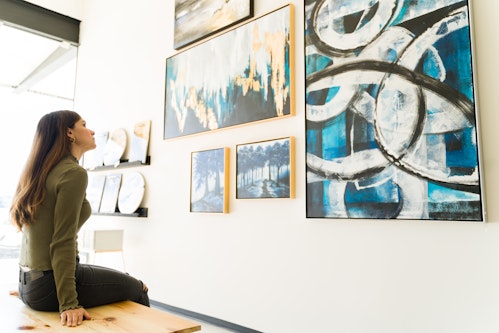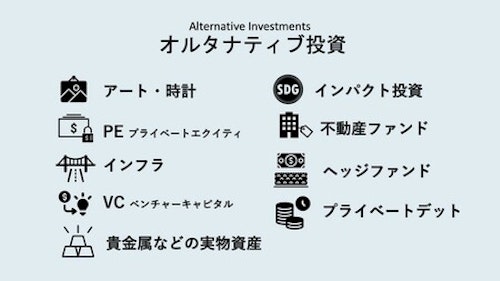
LIFE STYLE
Art thinking, design thinking, business thinking
Follow TRiCERA on Instagram and check out our creative artists
5%OFF & free shipping 1st purchase
FIRSTART5
10%OFF 2nd purchase after 1st purchase!
Welcome to TRiCERA
Hi there! We are pleased to have you here 🎉
Could you please describe yourself?
Guest
Art investment is a hot topic these days.
Various types of investments exist, including listed stocks and other fixed income securities.
Among them, a new area called "alternative assets" is attracting attention.
Alternative assets include infrastructure, private equity, real estate, forests, and paintings, which are less liquid than stocks and bonds.
The market for paintings has grown significantly over the past few years, and is arguably one of the most promising sectors. In this article, we will explain the advantages and disadvantages of art (painting) investment in a way that anyone can understand.
It is usually recommended to incorporate alternative assets in an investment portfolio to the tune of about 5% of total assets.
There are two reasons for this.
The first reason is that they work as a diversifying investment target for risk diversification, and the second reason is that alternative assets are less liquid than traditional assets, but are considered to have higher yields because of this.
For investors, the balance between the unpredictability of market movements and their own expectations is a point that they must always keep within their assumptions and be careful about.
Art investing can be a positive factor for investors who want to limit the effects of market volatility and may help them achieve their long-term investment goals even when market conditions are uncertain.
In addition to hedge funds, private equity, alternative credit, and real estate, alternative assets also include vintage cars, rare wines, and artwork, which we will discuss here.
See also.
The low correlation with traditional financial instruments means that while the stock and bond markets are falling, art works may rise in value without any relation to them.
Specifically, the art market in Europe, the U.S., and Greater China continues to grow in size, and the number of young collectors is increasing. (approximately over 9 trillion yen), a 3% increase over the previous year 2021, almost a V-shaped recovery to pre-Corona levels.
The average annual growth rate in the value of paintings is above 8%, and with the right pieces purchased and properly stored, one can expect to recoup a significant amount of money.
Also, while the lack of short-term returns and income gains is clearly a disadvantage, it is rather an advantage in that you can expect a long-term increase in value. This point can be said to be a difference in perspective on how to view the same characteristics.
First and foremost, art works are enjoyable to look at. Of course, you have to make your own decision on what kind of artwork to purchase, so in addition to "it is an artist whose price is likely to rise in the future" or "it is a work by an artist working in a popular genre today," the fact that it "resonates with you" is often a deciding factor in your decision to purchase.
In fact, top art dealers, of course, consider acquiring or selling a work based on its historical value and contemporaneous evaluation, but the basic premise is whether or not the work "struck a chord" with them after they themselves, with their various knowledge, have viewed it.
Also, another major advantage is "art thinking," which has become a hot topic in recent years with the publication of books on the subject.
In business and other fields, two basic types of thinking are required: "critical thinking" and "design thinking," but "art thinking" is being actively practiced as a third way of thinking that is different from either of these.
In a nutshell, Art Thinking is "starting from the individual problem.
Let's compare this with Design Thinking. Design Thinking is about "empathizing with the client, finding their latent needs, and solving them. The goal is to find previously unseen demands and new solutions by getting to know the person thoroughly.
In contrast, the purpose of Art Thinking is to "create value that has never existed before.
For example, Mr. Masamichi Toyama, the representative of Soup Stock Tokyo and a well-known practitioner of Art Thinking, used to create art himself. Using this experience, he has created a lifestyle that no one had ever imagined before, a lifestyle in which soup is the staple food, and the company has made such history that it will celebrate the 20th anniversary of its founding in 2019.
Artworks are not always priced up a month after you buy them.
You should expect a lock-up period of at least one year for even very popular artists, and usually several to a dozen years. This is because, from the perspective of the artist who is creating the work, it does not seem to be a recognition of his/her own value if the purchased work immediately goes into the secondary market, and the improvement of the work's reputation is achieved by the artist's growing fame through various media and through various exhibitions. This usually takes some time.
This usually takes some time.
There is some investment risk in that you cannot redeem or sell your holdings on a daily basis, but it is reasonable considering the type of assets you are dealing with.
While art investments can offer high returns if you own works by the right artists, they are also high risk.
Since the only cash point to begin with is the capital gain from your sale, there is no gain until you actually know whether or not the value will increase, and the time you perceive as risk tends to be longer.
It is not uncommon for an artist who is very popular today to find that the price of his/her work has dropped by half in a few years.
To avoid this, it is necessary to regularly collect up-to-date information and watch price fluctuations, as well as gather knowledge about art history and famous artists.
The value of art is quite largely based on whether the work is something that the majority of people think they have never seen before. Even if the work is a patchwork of existing styles from an expert's point of view, depending on how it is presented, a work of art may be created that generates value. By analyzing the work from a specialist's point of view, while at the same time taking a meta-view of how it will be received, you will be able to find effective investment targets.
The art buying process requires an understanding of the art market.
The art market is a very closed and narrow society, and for example, "a new work by a popular artist is only shown to a large group of customers who have already purchased a variety of works," or "a work by the same artist may be priced differently if the style is different from that of a popular artist.
It is advisable to gradually gain knowledge of the market and the atmosphere of the market, as some of the peculiarities are unavoidable.
If you have the opportunity to communicate face-to-face, such as by making an appointment at a gallery to talk with a gallerist or visiting an exhibition to talk directly with the artist, you will be able to get a feel for the atmosphere of the market more quickly.
Also read
Why Investing in Paintings is Popular among High Net Worth Individuals|A Thorough Explanation of Advantages, Disadvantages, and How to Get Started
How to invest in paintings [Recommended artists].
Art investment is hot right now! Young Japanese Artists to Watch
TRiCERA ART members enjoy a variety of benefits and priorities.
- Discounts such as members-only secret sales and coupons
- Create your own collection by registering your favorite artists
- Receive updates on popular artists, exhibitions, and events
- Receive a weekly newsletter with selected art
- Personal Assessment to find out what kind of art you like.
Please register as a member for free and receive the latest information.

Writer
TRiCERA ART
Art investment is a hot topic these days.
Various types of investments exist, including listed stocks and other fixed income securities.
Among them, a new area called "alternative assets" is attracting attention.
Alternative assets include infrastructure, private equity, real estate, forests, and paintings, which are less liquid than stocks and bonds.
The market for paintings has grown significantly over the past few years, and is arguably one of the most promising sectors. In this article, we will explain the advantages and disadvantages of art (painting) investment in a way that anyone can understand.
It is usually recommended to incorporate alternative assets in an investment portfolio to the tune of about 5% of total assets.
There are two reasons for this.
The first reason is that they work as a diversifying investment target for risk diversification, and the second reason is that alternative assets are less liquid than traditional assets, but are considered to have higher yields because of this.
For investors, the balance between the unpredictability of market movements and their own expectations is a point that they must always keep within their assumptions and be careful about.
Art investing can be a positive factor for investors who want to limit the effects of market volatility and may help them achieve their long-term investment goals even when market conditions are uncertain.
In addition to hedge funds, private equity, alternative credit, and real estate, alternative assets also include vintage cars, rare wines, and artwork, which we will discuss here.
See also.
The low correlation with traditional financial instruments means that while the stock and bond markets are falling, art works may rise in value without any relation to them.
Specifically, the art market in Europe, the U.S., and Greater China continues to grow in size, and the number of young collectors is increasing. (approximately over 9 trillion yen), a 3% increase over the previous year 2021, almost a V-shaped recovery to pre-Corona levels.
The average annual growth rate in the value of paintings is above 8%, and with the right pieces purchased and properly stored, one can expect to recoup a significant amount of money.
Also, while the lack of short-term returns and income gains is clearly a disadvantage, it is rather an advantage in that you can expect a long-term increase in value. This point can be said to be a difference in perspective on how to view the same characteristics.
First and foremost, art works are enjoyable to look at. Of course, you have to make your own decision on what kind of artwork to purchase, so in addition to "it is an artist whose price is likely to rise in the future" or "it is a work by an artist working in a popular genre today," the fact that it "resonates with you" is often a deciding factor in your decision to purchase.
In fact, top art dealers, of course, consider acquiring or selling a work based on its historical value and contemporaneous evaluation, but the basic premise is whether or not the work "struck a chord" with them after they themselves, with their various knowledge, have viewed it.
Also, another major advantage is "art thinking," which has become a hot topic in recent years with the publication of books on the subject.
In business and other fields, two basic types of thinking are required: "critical thinking" and "design thinking," but "art thinking" is being actively practiced as a third way of thinking that is different from either of these.
In a nutshell, Art Thinking is "starting from the individual problem.
Let's compare this with Design Thinking. Design Thinking is about "empathizing with the client, finding their latent needs, and solving them. The goal is to find previously unseen demands and new solutions by getting to know the person thoroughly.
In contrast, the purpose of Art Thinking is to "create value that has never existed before.
For example, Mr. Masamichi Toyama, the representative of Soup Stock Tokyo and a well-known practitioner of Art Thinking, used to create art himself. Using this experience, he has created a lifestyle that no one had ever imagined before, a lifestyle in which soup is the staple food, and the company has made such history that it will celebrate the 20th anniversary of its founding in 2019.
Artworks are not always priced up a month after you buy them.
You should expect a lock-up period of at least one year for even very popular artists, and usually several to a dozen years. This is because, from the perspective of the artist who is creating the work, it does not seem to be a recognition of his/her own value if the purchased work immediately goes into the secondary market, and the improvement of the work's reputation is achieved by the artist's growing fame through various media and through various exhibitions. This usually takes some time.
This usually takes some time.
There is some investment risk in that you cannot redeem or sell your holdings on a daily basis, but it is reasonable considering the type of assets you are dealing with.
While art investments can offer high returns if you own works by the right artists, they are also high risk.
Since the only cash point to begin with is the capital gain from your sale, there is no gain until you actually know whether or not the value will increase, and the time you perceive as risk tends to be longer.
It is not uncommon for an artist who is very popular today to find that the price of his/her work has dropped by half in a few years.
To avoid this, it is necessary to regularly collect up-to-date information and watch price fluctuations, as well as gather knowledge about art history and famous artists.
The value of art is quite largely based on whether the work is something that the majority of people think they have never seen before. Even if the work is a patchwork of existing styles from an expert's point of view, depending on how it is presented, a work of art may be created that generates value. By analyzing the work from a specialist's point of view, while at the same time taking a meta-view of how it will be received, you will be able to find effective investment targets.
The art buying process requires an understanding of the art market.
The art market is a very closed and narrow society, and for example, "a new work by a popular artist is only shown to a large group of customers who have already purchased a variety of works," or "a work by the same artist may be priced differently if the style is different from that of a popular artist.
It is advisable to gradually gain knowledge of the market and the atmosphere of the market, as some of the peculiarities are unavoidable.
If you have the opportunity to communicate face-to-face, such as by making an appointment at a gallery to talk with a gallerist or visiting an exhibition to talk directly with the artist, you will be able to get a feel for the atmosphere of the market more quickly.
Also read
Why Investing in Paintings is Popular among High Net Worth Individuals|A Thorough Explanation of Advantages, Disadvantages, and How to Get Started
How to invest in paintings [Recommended artists].
Art investment is hot right now! Young Japanese Artists to Watch
TRiCERA ART members enjoy a variety of benefits and priorities.
- Discounts such as members-only secret sales and coupons
- Create your own collection by registering your favorite artists
- Receive updates on popular artists, exhibitions, and events
- Receive a weekly newsletter with selected art
- Personal Assessment to find out what kind of art you like.
Please register as a member for free and receive the latest information.

Writer
TRiCERA ART